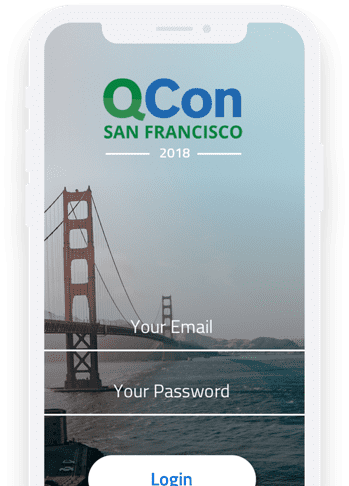Presentation: Netflix Play API - An Evolutionary Architecture
Share this on:
What You’ll Learn
-
Learn how to make decisions in your architectural design using the Type1/Type2 decision framework.
-
Understand how to ensure original architectural principles and decisions are maintained as architecture evolves.
-
Hear why evolvability and identity act as top guiding principles in the success of your architecture
Abstract
-
Three foundational principles that can guide you in designing a microservice architecture:
-
Why focussing on “identity” lays the foundation for your architectural design
-
Why it is important to identify Type1/Type2 decisions
-
Why evolvability is crucial, specifically when it comes to “known unknowns”!
-
Concrete lessons learned around:
-
Different types of coupling and its limitations
-
How we can choose a mix of async/sync architectures to unlock evolvability
-
Ensuring we are not building a Data Monolith
QCon: What is the focus of your work today?
Suudhan: I work on the Playback API team whose identity is to deliver Playback Functionality 24/7. I, along with a team of stunning colleagues, own and operate the critical Play API service which orchestrates playback functions like deciding the best playback experience, authorize every playback and collect playback data for business intelligence. For the past 2 years, i lead the initiative to re-architect this service to significantly improve our scalability, availability and developer velocity.
QCon: What’s the motivation for this talk?
Suudhan: Our API service have gone through 3 architectures. With Netflix scale, we often hit limitations of our architecture every 3 or so years. In this third iteration, we have architected a solution to optimize for evolvability. We fully expect things to change in 3-5 years time and we want an architecture in which each aspect of the architecture can be replaced with minimal overhead. My motivation for the talk is to share our learnings with this architecture and have an exchange of ideas with the qCon audience. I am particularly interested in hearing opinions about aspects which we might have overlooked or how some elements of our architecture can be applied to different domains.
QCon: How you you describe the persona and level of the target audience?
Suudhan: Target audience is a senior software engineer who has had some experience with owning and operating services. The talk will appeal to persons who are thinking about re-architecting any part of their services; or starting afresh on a new architecture.
What technology problem keeps you up at night?
Suudhan: These are some of the problems i am thinking about:
1) How to convert real-time data services to materialized views to significantly improve our throughput and reduce point of failures in our critical systems.
2) How to isolate request-response style APIs from fire and forget ones to optimize for different attributes (like availability for the former and consistency for the latter)
3) When we see an availability drop, how to shed load by smartly degrading our user experience till the issue is resolved
Similar Talks




Tracks
Monday, 5 November
-
Microservices / Serverless Patterns & Practices
Evolving, observing, persisting, and building modern microservices
-
Practices of DevOps & Lean Thinking
Practical approaches using DevOps & Lean Thinking
-
JavaScript & Web Tech
Beyond JavaScript in the Browser. Exploring WebAssembly, Electron, & Modern Frameworks
-
Modern CS in the Real World
Thoughts pushing software forward, including consensus, CRDT's, formal methods, & probabilistic programming
-
Modern Operating Systems
Applied, practical, & real-world deep-dive into industry adoption of OS, containers and virtualization, including Linux on Windows, LinuxKit, and Unikernels
-
Optimizing You: Human Skills for Individuals
Better teams start with a better self. Learn practical skills for IC
Tuesday, 6 November
-
Architectures You've Always Wondered About
Next-gen architectures from the most admired companies in software, such as Netflix, Google, Facebook, Twitter, & more
-
21st Century Languages
Lessons learned from languages like Rust, Go-lang, Swift, Kotlin, and more.
-
Emerging Trends in Data Engineering
Showcasing DataEng tech and highlighting the strengths of each in real-world applications.
-
Bare Knuckle Performance
Killing latency and getting the most out of your hardware
-
Socially Conscious Software
Building socially responsible software that protects users privacy & safety
-
Delivering on the Promise of Containers
Runtime containers, libraries, and services that power microservices
Wednesday, 7 November
-
Applied AI & Machine Learning
Applied machine learning lessons for SWEs, including tech around TensorFlow, TPUs, Keras, PyTorch, & more
-
Production Readiness: Building Resilient Systems
More than just building software, building deployable production ready software
-
Developer Experience: Level up your Engineering Effectiveness
Improving the end to end developer experience - design, dev, test, deploy, operate/understand.
-
Security: Lessons Attacking & Defending
Security from the defender's AND the attacker's point of view
-
Future of Human Computer Interaction
IoT, voice, mobile: Interfaces pushing the boundary of what we consider to be the interface
-
Enterprise Languages
Workhorse languages found in modern enterprises. Expect Java, .NET, & Node in this track








